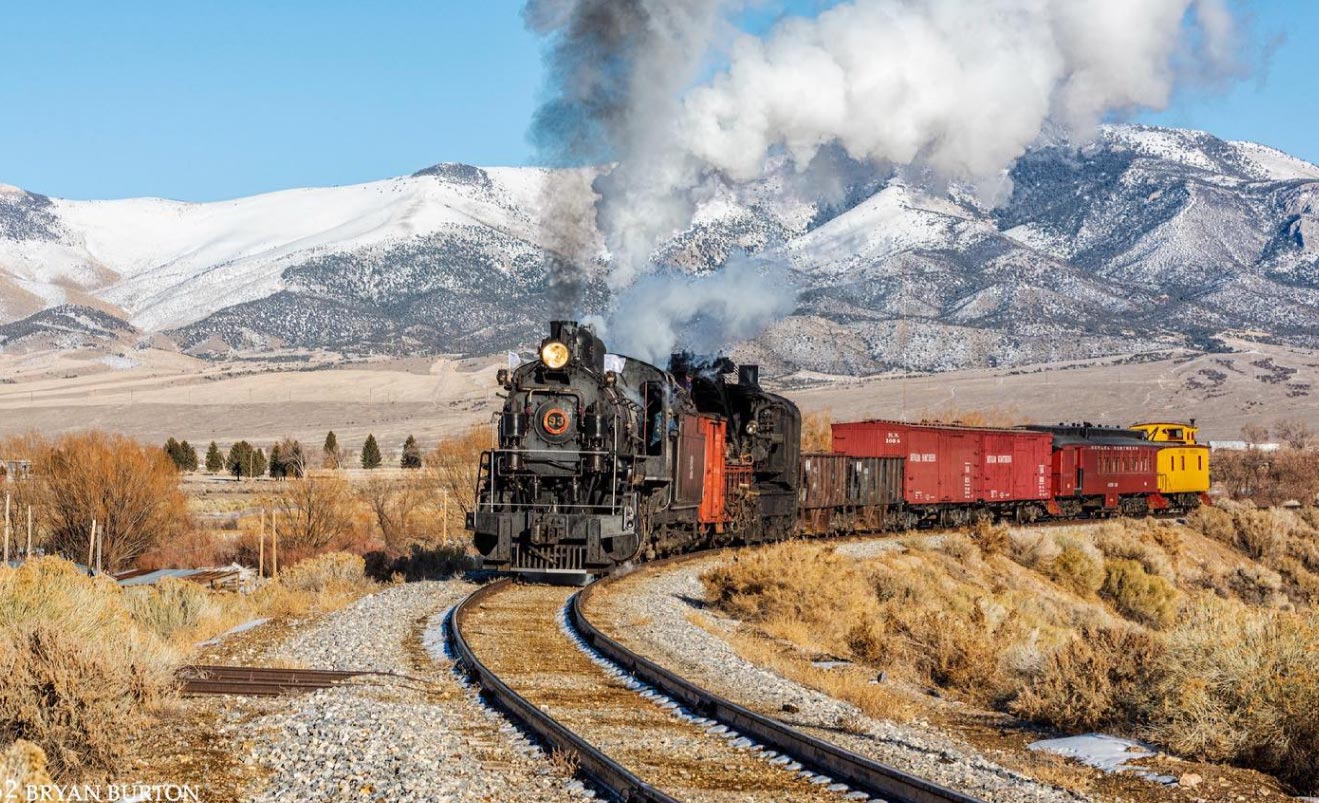Nevada Northern Railway #93
Exhibit Code
#93

Listen To Our Audio Tour
Train Conductor Mike, take it away!
Description
On July 10th, 1907, the Nevada Northern submitted an order to the American Locomotive Company for large 2-8-0 locomotives to haul ore trains between the mines near Ruth and the smelter at McGill. The first two, #90 & #91 were delivered in May 1908, with an additional 3rd and 4th locomotive added on later.
The 4th locomotive, #93, was completed January 1909, and left the factory on January 20th, arriving in Ely February 8th. Quickly put into Ore Service, the locomotive could also be found pulling the Veteran Suburban (commuter service between East Ely and the mining communities of Ruth, Kimberly, and Veteran) and freight trains down the Steptoe Valley.
#93 was constructed to the 2-8-0 wheel arrangement, which were nicknamed “Consolidations”. These locomotives have a two-wheel leading truck up front, eight driving wheels, and no trailing wheels. The Consolidation-type was very popular on the Nevada Northern, as eleven of the type were rostered.
With small 52” drivers, #93 and the other 90-class (all of the ore engines were ultimately numbered 90 through 98) were well suited to pulling 20 and later 30 ore cars from the main mine yard at Copper Flat through East Ely to McGill. However, running the 90-class down the main line was rough on the locomotives.
On September 1st, 1920, all 8 ore locomotives (90-97, 98 would be purchased in 1929), the 6 bobber cabooses, and the ore car fleet were transferred from Nevada Northern ownership to Nevada Consolidated Copper Company. From this point on, all ore trains would be operated by Nevada Con (N.C.C.Co.), having trackage rights over the Nevada Northern and dispatched by the N.N. Dispatcher. All equipment was re-lettered to N.C.C.Co.
#93 and the other 90-class would also live in the East Ely Roundhouse (today known as the Engine House), and maintained by the East Ely Machine Shop staff. Additionally, the Nevada Northern had the right to “rent” (aka, borrow) one of the 90-class for their own power if needed.
Through all of this, #93 continued to run mainly hauling ore trains. Sidelined in the early 1930’s due to the Great Depression, the locomotive worked hard during the 1940’s. By 1948, #93 was showing her age, so a General Manager’s Order (GMO) was issued September 1948 for a Class 3 overhaul including a new set of cylinders, dropping the wheels and turning the tires, and the installation of a new firebox.
By September 1949, all work on #93 was completed, but the situation had changed on the railroad. The first Alco RS-2, #101, showed up shortly after #93 had entered the shop in 1948, and quickly proved its worth in the Liberty Pit. A second RS-2, #102, showed up in early 1949, and following its success Kennecott ordered an additional RS-2 followed by an order for four.
With the other 8 90-class in service hauling trains, and new diesels on the way, #93 was held as protection for service, but the writing was clear: the steam locomotives were on borrowed time.
December 21st, 1949 RS-2 #103 entered service pulling ore trains. Following the introduction of RS-2 #105 on January 24th, 1950, all regular steam-powered ore trains ended. Kennecott and the Nevada Northern begin pulling 90-class from service and storing the locomotives. #93 was placed in storage on March 1st, 1950.
On April 18th, 1951, #93 returned to service assisting #81 on the main line freights, pulling the local freight trains, and pulling the occasional ore trains. By June 1951, Kennecott Copper Corp. RSD-4 #201 arrived and was tested on the main line freight trains. Proving successful, both #81 and #93 were brought out less and less. In September 1952, Nevada Northern SD-7 #401 arrived at Ely, and after solving some teething problems, #81 and #93 were stored
The Nevada Northern held onto both locomotives until their tubes expired around 1956. With #93, #81, and #40 being the last steam locomotives on the property, the railroad decided not to scrap #93. Towed out for various railfan groups visiting in the late 50’s, the locomotive’s fate remained uncertain.
In 1961 #93 made what many believed to be its last journey when it was pushed down the mainline to the new White Pine Public Museum alongside #81, who had been placed on display the previous year. For the next 29 years, #93 stood next to Aultman St, seemingly destined to be nothing more than a static reminder of the history of White Pine County.
In 1990, plans were made to return #93 back to the East Ely yard as the fledgling Museum realized that a second locomotive would be needed to assist #40 with excursion trips. Chosen due to the 1949 overhaul, #93 returned to service appropriately in ’93. Thanks to the tireless work of the volunteers restoring the locomotive, #93 debuted with a custom number plate thanking all of the Museum’s volunteers for their service.
In October 2001, #93 was rebuilt to bring the locomotive into compliance with new FRA (Federal Railroad Administration) regulations. This led to a happy coincidence, where the Heber Valley Railroad was looking for a third steam locomotive to assist with projected traffic during the 2002 Winter Olympics. #93 and coaches #07 & #08 left for Utah, assisting with the Olympic Torch Relay and pulling thousands of happy passengers.
Historical Archive
You can find more information about this article in our Historical Archive hosted on Luma Imaging.
Specifications
Builder: American Locomotive Works - Pittsburgh #44604
Built: January 1909
Type: 2-8-0 Consolidation
Horsepower: 41,890 lbs.
Weight: 187,000 lbs. (93 1/2 tons)
Can’t get enough of our Rich History?
If you have any questions or want to request more information for a certain train or equipment, contact us here.